A Comprehensive Guide For Youth Soccer Goal Kick Drills
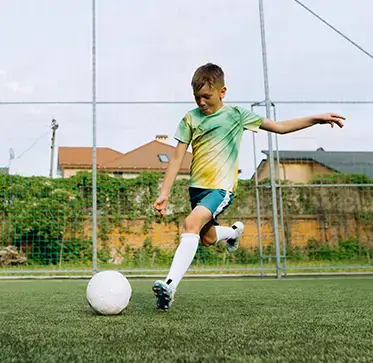
CRFC BLOGS
LATEST BLOGS & NEWSLETTERS
A Comprehensive Guide For Youth Soccer Goal Kick Drills
Soccer goal kick drills are a fundamental part of training for young soccer players. Mastering these youth soccer goal kick drills can help players retain possession, advance the ball effectively, and avoid turnovers. This comprehensive guide will cover various aspects of youth soccer goal kick techniques, drills tailored for different age groups, and essential rules to follow.
Fundamentals of Youth Soccer Goal Kicking Technique
Understanding the basics of youth soccer goal-kicking technique is essential. These basics are the foundation of youth soccer ball kick drills, designed to improve overall technique and accuracy. Practicing these elements will help players develop a consistent and powerful goal kick.
-
Planting the Foot
The non-kicking foot should be placed firmly beside the ball, pointing in the direction you want the ball to go. This provides balance and stability.
-
Pulling the Leg Back
The kicking leg should be pulled back to generate power. The further back you pull, the more force you can apply to the kick.
-
Hitting the Ball
Striking the ball with the right part of the foot is crucial. Aim to hit the ball with the instep (the part of the foot where the laces are) for a robust and accurate kick.
-
Body Positioning
Maintaining a slight forward lean with your upper body when striking the ball. This helps keep the ball low and controlled. Avoid leaning too far back, as this can cause the ball to rise too much, making it easier for opponents to intercept.
-
Follow-Through
A good follow-through is essential for power and accuracy. After striking the ball, continue your kicking motion towards your target. Your foot should land in the direction you want the ball to go. This helps transfer maximum power and guide the ball accurately.
Youth Soccer Short Goal Kick Drills
Short goal kicks are a clever tactic to keep control of the ball and start building an attack from the back of the field. These kicks are especially helpful when playing against teams that put much pressure on the goalkeeper and defenders.
Here’s how to execute short goal kicks effectively:
Goalkeeper’s Role
The goalkeeper plays a critical role in initiating short passes. They must know their teammates’ positions and the opposition’s press.
Defenders’ Movement
Defenders should spread out and move into space to receive the ball. Proper goal-kick positioning ensures players are in the right spots to receive the pass.
Quick Passes
The goalkeeper should aim to deliver quick, accurate passes to defenders or midfielders. These players should be ready to control the ball and continue the play.
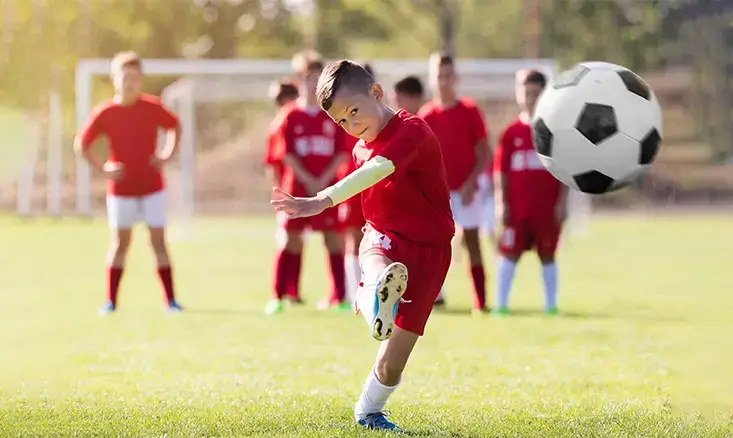
Practical Drill for Youth Soccer Short Goal Kicks:
Set-Up
Place cones to mark out spaces where defenders should position themselves.
Execution
The goalkeeper practices passing the ball to these marked areas, with defenders moving to receive the ball.
Focus
Emphasizes quick, accurate passes and immediate control by the receiving player.
Youth Soccer Long Goal Kicking Drills
Long goal kicks are helpful when the opposing team plays with a deep defensive setup or when your team has players who can win aerial duels. These kicks can help advance the ball quickly and create scoring opportunities.
Here are some tips for effective long-goal kicks:
Timing Runs
Players need to time their runs to coincide with the goalkeeper’s kick. This helps you get to the ball first.
Winning Aerial Duels
Players, especially forwards, should be trained to win headers and flick-ons. This can create chances for other attackers.
Accuracy and Power
The goalkeeper must strike the ball with enough power and accuracy to reach the intended target.
Practical Drill for Long Goal Kicks:
Set-Up
Position forwards and midfielders in various spots upfield.
Execution
The goalkeeper practices kicking the ball to these players, who then attempt to control the ball or flick it onto another player.
Focus
Emphasize the importance of timing and positioning to win the ball in the air.
Youth Soccer Goal Kick Drills for Different Age Groups
Designing goal kick drills for different age groups ensures that players develop the appropriate skills for their level. Here are some youth soccer goal kick drills for various age groups:
Youth Soccer Goal Kick Drills for U8
Basic Pass and Move Drill
Set-Up
Create a small grid on the field.
Execution
Have the goalkeeper practice short passes to defenders. The defenders then pass to midfielders.
Focus
This youth soccer passing drill emphasizes control and accuracy to build fundamental skills.
Target Practice Game
Set-Up
Place cones or targets around the field.
Execution
Players kick the ball to hit the targets.
Focus
Enhance kicking accuracy while keeping young players engaged with a fun activity.
Youth Soccer Goal Kick Drills for U10
Mixed Kick Accuracy Drill
Set-Up
Arrange cones in a line upfield.
Execution
The goalkeeper practices short and long kicks to players positioned at each cone. Players work on receiving and passing the ball quickly.
Focus
Improve accuracy and decision-making skills.
Team Coordination Drill
Set-Up
Set up markers for different positions on the field.
Execution
Players communicate and coordinate their movements to receive passes from the goalkeeper and advance the ball upfield.
Focus
Build teamwork and understanding among players.
Youth Soccer Goal Kick Drills for U12
Long Kick Strategy Drill
Set-Up
Position players upfield in various spots.
Execution
The goalkeeper practices long-distance kicks aimed at different players, who control and pass the ball strategically.
Focus
Develop long-distance kicking accuracy and strategic play. In addition to mastering long-distance kicks, players can further enhance their skills and teamwork by participating in structured training programs like our soccer summer camp.
Pressure Decision Drill
Set-Up
Simulate a game situation with defenders and attackers on the field.
Execution
The goalkeeper must choose between a short or long kick based on the positioning of defenders and attackers.
Focus
Improve decision-making under pressure and execution of goal kicks.
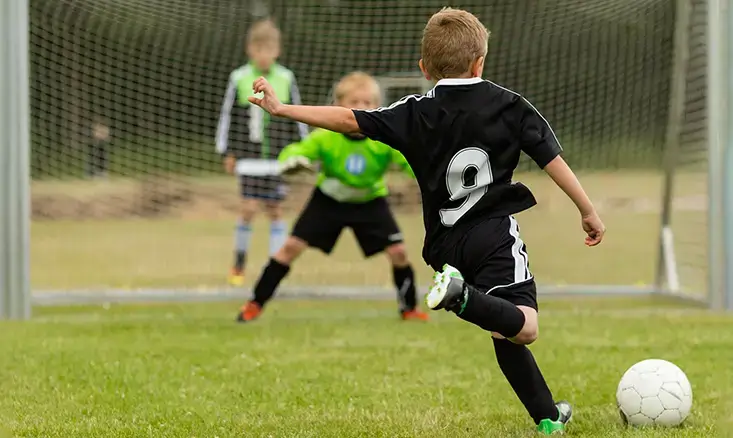
Youth Soccer Goal Kick Drills
Youth soccer goal kick drills enhance various aspects of goal kicking and help players develop their skills in passing, positioning, and strategic play. Players can create a range of skills necessary for effective goal-kicking by incorporating these detailed goal-kick drills into training sessions. Each drill targets specific aspects of the game, from controlled passing and spatial awareness to quick, strategic plays. Regularly practicing these drills will enhance players’ abilities to execute goal kicks under various game conditions.
Controlled Passing Drill
Set-Up
Position the goalkeeper, fullback, midfielder, and central defender in their respective areas.
Execution
The drill begins with the goalkeeper passing the ball to the fullback. The fullback then moves into space, receiving the pass. Next, the fullback passes to the midfielder, who is positioned to control the ball. The midfielder then looks for the central defender and passes the ball to them. Finally, the central defender advances the ball further upfield.
Objective
This drill focuses on maintaining possession through a series of controlled passes. It encourages players to move into space and support each other, helping improve passing accuracy, ball control, and spatial awareness.
Key Points
- Ensure each player moves into space to receive the pass.
- Emphasize the importance of accurate, controlled passes.
- Encourage players to communicate and anticipate the next pass.
Drill Utilizing Space and Fullback Advancement
Set-Up
Position the goalkeeper, winger/midfielder, and fullback in their respective areas.
Execution
The goalkeeper starts by playing the ball to the winger or midfielder, who drops back into space to receive the pass. The winger then controls the ball and passes it back to the fullback, who is positioned to move forward with the ball. The fullback then advances up the field.
Objective
This drill aims to use the space on the field effectively and create opportunities for advancing the ball through the fullbacks. It helps players understand positioning, movement, and the importance of utilizing open space.
Key Points
- The winger/midfielder should drop back into space quickly to receive the pass.
- Fullback should be ready to move forward and take advantage of the space created.
- Focus on quick transitions and maintaining possession.
Quick Goal-Kick to Center-Forward Drill
Set-Up
Position the goalkeeper and center-forward. Other attackers can be positioned to exploit the flick-on.
Execution
The goalkeeper takes a quick goal kick, aiming directly for the center forward. The center forward, positioned ahead, tries to flick the ball into the space behind the defensive line for another attacker to run onto. This quick-play aims to catch the opposition off guard before they can set up their defensive positions.
Objective
This drill focuses on quick, strategic plays to exploit gaps in the opposition’s defense. It helps improve the goalkeeper’s long-distance kicking accuracy and the center-forward’s ability to win aerial duels and make quick decisions.
Key Points
- The goalkeeper should take the kick quickly to exploit the opposition’s unsettled defense.
- Center-forward should time their run to meet the ball and flick it accurately.
- Other attackers need to anticipate the flick-on and be ready to capitalize on the opportunity.
Youth Soccer Goal Kick Positioning
Proper goal-kick positioning is crucial for both the goalkeeper and the receiving players.
Common Mistakes
Kicking Aimlessly
Avoid kicking the ball aimlessly downfield. Always have a target and a plan.
Poor Positioning
Receiving players should position themselves in spaces where they can easily control the ball and know the opposition’s positioning.
Lack of Communication
Players must communicate clearly to ensure everyone knows their roles during a goal kick.
Solutions
- Use drills that improve accuracy and decision-making.
- Emphasize the importance of communication and movement during training sessions.
- Encourage players to practice goal kick positioning regularly.
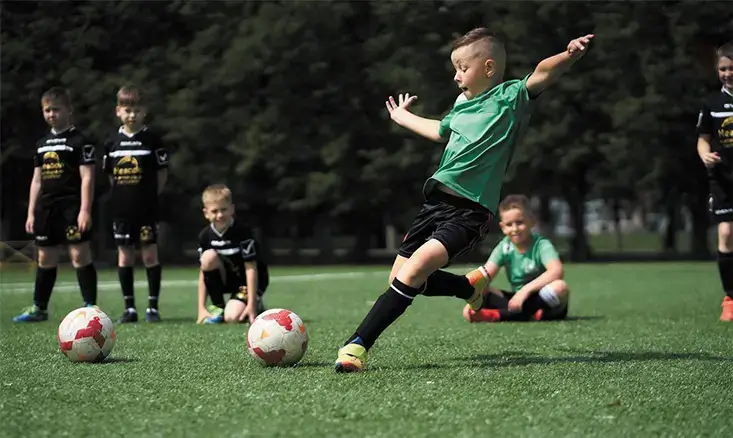
Youth Soccer Goal Kick Rules
Knowing these rules helps in planning effective drills and ensuring compliance during matches. Coaches should regularly review these rules with their players to prevent infractions during games. Understanding youth soccer goal-kick rules is essential for both players and coaches.
These rules can vary slightly depending on the age group, but here are some general guidelines:
Ball Placement
The ball must be placed inside the goal area.
Opposition Distance
Opposing players must remain outside the penalty area until the ball is in play.
Ball in Play
The ball is in play once it leaves the penalty area.
Advanced Strategies for Youth Soccer Goal Kicking
Advanced strategies for youth soccer goal-kicking involve building play from the back and adjusting tactics based on the opposition. Here’s how to implement these strategies:
Building Play from the Back
This involves maintaining ball control and proper positioning. Defenders and midfielders play critical roles in advancing the play. The aim is to keep possession and move the ball upfield methodically, reducing the risk of turnovers.
Maintain Ball Control
Ensure the goalkeeper, defenders, and midfielders are comfortable with the ball. They should be able to pass accurately and move into space.
Proper Positioning
Players should spread out and position themselves to receive the ball effectively. This creates multiple passing options and prevents the opposition from easily intercepting the ball.
Adjusting to Opposition
Recognize and counter different defensive setups. The tactics should vary depending on how the opposition positions themselves:
High Press
If the opposition presses high, use short passes to outmaneuver their forwards and midfielders. Quick, accurate passes between defenders and midfielders can help break the press.
Deep Defense
Consider using long kicks to bypass the crowded midfield if the opposition plays deep. Long kicks can target forwards positioned to win aerial duels and create scoring opportunities.
Practical Strategy for Game Situations
Assessing the Opposition
Instruct the goalkeeper to evaluate the opposition’s positioning before executing a short or long kick. This decision-making process is crucial for choosing the most effective strategy.
Simulating Game Scenarios
To practice these decisions, use drills that mimic real game situations. For example, set up drills in which the goalkeeper must choose between a short pass to a defender or a long kick to a forward based on the opposition’s press.
Practical Application of Youth Soccer Goal Kick Drills
Implementing youth soccer goal kick drills in practice sessions requires careful planning to ensure players develop the necessary skills effectively.
Here are some tips to help structure your sessions:
Structuring Sessions
Plan practice sessions that include a mix of short and long kick drills. This variety ensures players are well-rounded and can handle different game situations.
Age-Appropriate Drills
Use drills tailored for different age groups, from U8s to U12s. Younger players must focus on basic techniques, while older players can handle more advanced drills.
Adapting Based on Skill Level
Adjust the difficulty of drills based on the players’ skill levels. Ensure that each player is challenged appropriately to facilitate continuous improvement.
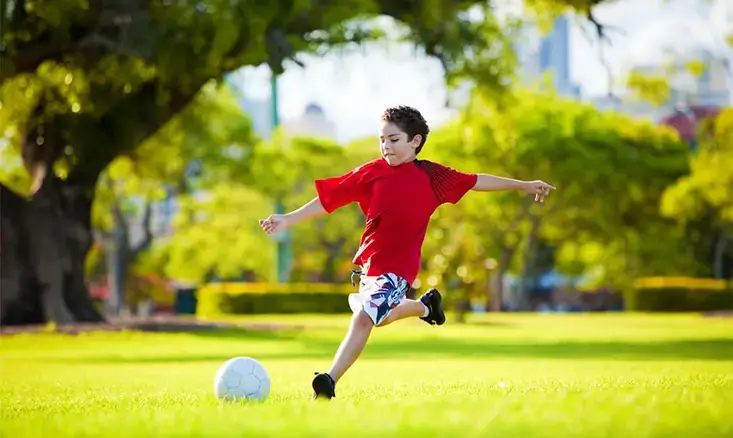
Detailed Example of Youth Soccer Goal Kick Practice Plan
Players can effectively develop their goal-kicking abilities by carefully structuring practice sessions and using drills tailored to age and skill levels. Regular practice and realistic game simulations ensure players are well-prepared for match situations.
Warm-Up
- Set-Up: Players spread out in a large circle.
- Execution: Each player practices basic kicks to a partner, focusing on technique.
- Time: 10 minutes.
Short Kicks
- Set-Up: Mark positions for defenders and midfielders.
- Execution: The goalkeeper practices short passes to defenders, who then pass to midfielders.
- Time: 15 minutes.
- Objective: Enhance passing accuracy and positioning.
Long Kicks
- Set-Up: Position players upfield at various distances.
- Execution: The goalkeeper practices long goal kicks to these players, who then control and pass the ball.
- Time: 15 minutes.
- Objective: Improve long-distance kicking accuracy and receiving skills.
Game Simulation
- Set-Up: Divide players into two teams.
- Execution: Play a mini-game where the goalkeeper must decide between short and long kicks based on the scenario.
- Time: 20 minutes.
- Objective: Apply techniques in a game-like setting, enhancing real-time decision-making.
Conclusion
Effective youth soccer goal kick drills are essential for developing young players’ skills. Players can enhance their overall game by mastering short and long goal kicks and becoming more confident on the field. Consistent practice and adaptability are crucial to success. Coaches are encouraged to integrate these drills into regular training sessions to help players improve their performance.
FAQs
How do you teach goal kicks in youth soccer?
Start by showing young players the correct technique, practice short and long kicks, and use fun drills to improve their accuracy and power.
How do you teach soccer kicks to kids?
Teach the basics, such as planting the foot beside the ball, pulling the kicking leg back, striking the ball with the instep, and following through with the kick.
What is a goal kick in a youth soccer game?
A goal kick is when the goalkeeper kicks the ball from the goal area after the opposing team has kicked it over the goal line.
How do you get more height on goal kicks for youth players?
Teach kids to kick the ball lower and lean back slightly to lift it higher into the air.
What are the five steps for young players to follow to kick a soccer ball?
- Plant your non-kicking foot beside the ball.
- Pull your kicking leg back.
- Strike the ball with the instep of your foot.
- Follow through with your kicking motion.
- Aim your foot towards your target.

Did you find this useful?


